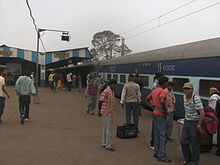- Coromandel Express
-
,
 The Coromandal Express halted at Kharagpur Junction
The Coromandal Express halted at Kharagpur Junction
The Coromandal Express is one of the flagship carriers of the Indian Railways. It is a superfast train which runs down the east coast of India between Howrah station(HWH) in Howrah (Kolkata) and Chennai Central(MAS) in Chennai daily. It is one of the earliest superfast express' in the history of IR. The Eastern Coast of India along the Bay of Bengal is called the Coromandal Coast and hence the name was given to this train, as it traverses the entire length of Coromandal coast. This train belongs to the South Eastern Railway. The train numbers are 2841 and 2842. 2841 departs from Howrah at 14.50 hrs and arrives at Chennai Central at 17.15 hrs the next day. 2842 departs from Chennai Central at 8.45 hrs and arrives at Howrah at 12.00 hrs (again, the next day).[1] The route covers a distance of 1662 km each way. The land of the Chola dynasty was called Cholamandalam in Tamil, literally translated as “the realm of the Cholas”, from which Coromandal is derived. The Coromandal Coast is the name given to the southeastern coast of the Indian peninsula.
Contents
Loco links
This train is hauled by CLW manufactured WAP 4 class electric locomotives maintained by Electric Loco Shed Santragachi of South Eastern Railway from Howrah to Visakhapatanam and thereafter by Royapuram based loco to Chennai as per loco links approved by Railway Board. These 5000 hp locomotives are fit to run at 130 kmph but due limitation of sectional speed, coromandal express runs at a maximum permissible speed of 110 kmph. Immediately after electrification, this train was hauled by Secunderabad (Lalaguda) based WAP4 loco from Chennai to Howrah but due to difficulty and excessive time required to reverse loco at Vishakhapatnam, subsequently it was decided to run it by Santragachi based Loco from Howrah to Vishakhapatnam and from Vishakhapatnam to Howrah by Erode based loco. When Royapuram shed came up near Chennai, Royapuram based loco is utilised to haul it from from Vishakhapatnam to Howrah.
Prior to completion of electrification of east coast line, there was no alternative but to run this train by by two WDMs(From Kharagpur Diesel Loco Shed). Reason for using two diesel locomotives was limited hauling capability of single WDM diesel locomotive to run this 24 coach train at 110 kmph. After electrification, single WAP4 electric locomotive is adequate. Thus there was straightway saving of one locomotive for Indian Railway. There was saving of time as well due faster acceleration.
This train had a serious accident in which apart from other damages and casualties one Santragachi based WAP4 loco got damaged beyond economical repair and therefore had to be condemned.
Speed
This train traverses the total distance of 1662 km in a total time of 27h 5m with the maximum speed of 110 km/hrs
Composition
The rake consists of 12 Sleepers, 6 AC Coaches(1AC, 2AC, 3AC), Pantry car, 3 General sitting and 2 SLRs. This train shares its rakes with the Howrah Chennai Mail. Thus a rake of the Coromandal Express consists of 24 coaches.
Route
This train runs non-stop between Chennai and Vijayawada (2842 has a stop at Ongole for Pantry purposes, hence it became a commercial stop with time) covering 432 km in 6½ hours. Then it runs up to Vishakapatnam with a single stop at Rajamundhry. However the run between Vijayawada and Visakhapatnam is slower (6 hrs 25 min) as compared to other superfast expresses(like Ratnachal Express/Falaknuma Express) in this route, despite only a single stop in this section. The other stops are Berhampur, Khurda Road, Bhubaneswar, Cuttack, Bhadrakh, Balasore and Kharagpur. Hence, it has a net of three stops in Andhra Pradesh, six stops in Orissa, one in West Bengal other HWH and MAS. When it was introduced in 1977, it had stops only at Vijayawada, Visakhapatnam, Bhubaneswar. It used to bypass Cuttack and Khurda Road was a technical halt. Later stops like Bhadrakh, Balasore etc. were introduced. The run has slowed down considerably as compared to the earlier days. It had a distinct livery when it was introduced in 1977.
Bridges
This train passes over some important rivers of India:
- Krishna river in Vijayawada Speed-110 km/hrs
- Godavari in Rajmundhry: 2.74 KM Speed-110 km/hrs
- Mahanadi in Cuttack: 2.1 KM Speed-110 km/hrs
- Kathjori(Mahanadi distributary)in Cuttack Speed-100 km/hrs
- Kuakhai(Mahanadi distributary) near CuttackSpeed-100 km/hrs
- Subarnarekha near Balasore. Speed-70 km/hrs
- Brahmani. Speed-70 km/hrs
- Sea backwater near Ennore chennaiSpeed-50 km/hrs
- Pennar near Nellore. Speed-60 km/hrs
- Damodar near Bagnan. Speed-50 km/hrs
- Rupnarayan near Kolaghat/Mecheda. Speed-50 km/hrs
Accident
On 13 February 2009, the train derailed near Jajpur Road about 100 km away from Bhubaneswar in Orissa killing at least 15 people and leaving several injured, some critically. The reason for the derailment is not known. A high level inquiry was ordered by the Railways following the incident.[2]
References
- ^ "Indian Railways Reservation Enquiry Website". http://www.indianrail.gov.in. Retrieved 2007-02-23.
- ^ "Fifteen dead in India train accident". http://www.google.com/hostednews/afp/article/ALeqM5iBkvpDQcLV5abWff2DL_FunVqHcA. Retrieved 2009-02-14.
- 'Trains at a glance' - the timetable published by Indian Railways in December 2006.
Categories:- Superfast trains
Wikimedia Foundation. 2010.
